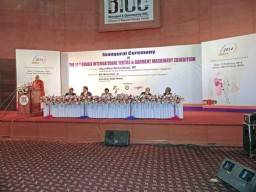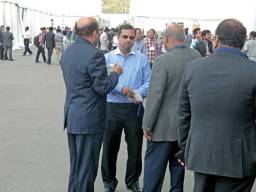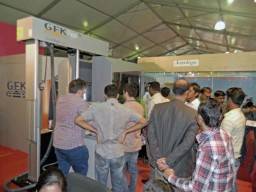
A much needed exposition for the industry after a long period of instability, the 2014 edition of the DTG fair, long considered the ITMA of Bangladesh, offered the industry latest technologies and solutions in fabric manufacturing and processing along with the same for apparels. Other interesting additions to this year’s show was a separate space accommodating yarn, fabric and accessory suppliers from China, Taiwan, Korea and other countries belonging to the eastern hemisphere of Asia. Inaugurated by the Finance Minister of Bangladesh, Abul Maal Abdul Muhith, the fair had 850 exhibitors from more than 30 countries, highlighting the importance of the country’s textile industry for the world. Also praising the occasion with his presence, Jahangir Alamin, President, BTMA (Bangladesh Textile Manufacturers Association) said, “Despite the political unrests which hindered the growth of the country’s apparel and textile sector, we witnessed a total investment of more than US $ 300 million in the textile sector alone, aimed at capacity building in areas of spinning, knitting, weaving and processing.”
With the increased wages, each and every apparel manufacturer is considering solutions for productivity improvement and better manpower optimization more than ever. The buyers are ready to share the burden of increased labour wages but they want the factory to share with them parameters which define their productivity and efficiency like man-machine ratio, output per operator per minute and other such parameters, which would actually create a win-win situation for all as the operators produce more and get paid better, the manufacturers make more money by better utilization of the in-house resources and eventually the buyers get a better quality product without any delays. Due to this most companies are also considering solutions for utilization of the existing infrastructure for improving their profit margins instead of putting up more manufacturing facilities.


Even after all the incidents and wage hike, the buyers have still stuck to the country and even more are coming, but the tolerance level of buyers towards the country’s apparel and textile manufacturers has lowered too. “There is a lot of pressure for not only producing a quality product in an efficient and sustainable manner, but also promising on-time delivery and the failure to do so results in no more orders. Due to this, most of the companies are now focussing on producing at least 40% of their fabrics requirement in-house irrespective of the costs, while sourcing the rest from China and India,” shares Walter Leung, Director Sales & Marketing, Fong’s. Due to the above predications and thought-processes technology suppliers like Shima Seiki, Stoll, Fong’s, IMA, MACPI and Picanol showcased some of their most advanced machines, which one would only see at fairs like Texprocess, Germany or CISMA, China only. Most of the advanced fabric knitting, weaving and processing machines showcased at the DTG show were already with a sold sign for production facilities of Noman Group, Fakir Knitwear, Knit Concern and Robintex Group, highlighting the progress of Bangladesh’s textile industry which is undeterred by the yet to be solved power crisis in the country. This fact also endorses the direction of country’s product development which is focussed more on fabric processing and washing instead of printing and embroidery, as only one company, the NAF Group, has displayed printing and embroidery machines at the DTG fair.
[bleft] Most of the flat knitting machine suppliers and manufacturers are looking at strengthening their support to the industry by setting up training centres and hiring more technical staff personnel than sales people.
To further exploit the potential of the country as a flat knitting nation, the focus is on developing capacities for manufacturing sweater yarn and be more proactive in terms of product development as said by all visitors.
Most of the advanced fabric knitting, weaving and processing machines showcased at the DTG show were already with a ‘sold’ sign for production facilities of Noman Group, Fakir Knitwear, Knit Concern and Robintex Group. [/bleft]
Another trend which came under the spotlight was the presence of numerous Chinese knitting machines manufacturers, presently acquiring a major share of the fabric knitting market and making it tough for not so price-competitive European knitting machine manufacturers like Terrot, Mayer & Cie and Santoni. But with the industry moving up the value chain, most of the machine suppliers believe that the same is about to change. “We have already made our presence in the market with our basic circular knitting machines but now we have started getting queries for our advanced range of knitting machines,” adds Gianpiero Valsecchi, Area Sales Manager, Santoni which showcased its seamless garment knitting machines at the DTG show for the first time.
Sweater is still a dominant product category sourced from Bangladesh as the country is gaining a lot from the sweater business moving out of China due to the rising costs of manufacturing, as highlighted in Apparel Online’s coverage of DTG last year. This can only be attributed to the growing scales of flat knitting in the country. “Sweater is not just about installing automatic flat knitting machines, you need a large workforce for operations of linking and mending, and that too quite skilled which Bangladesh has,” asserts Thomas Hoffmann, Area Sales Manager, Stoll who foresees the coming five years as the time of revolution for the flat knitting industry of the country which would result in greater automation. To further exploit the potential of the country as a flat knitting nation, the focus is on developing capacities for manufacturing sweater yarn and be more proactive in terms of product development as said by all visitors. “Flat knitting machines are very versatile and can make products beyond sweaters, which the people need to understand and exploit for creating a wider basket of flat knit apparel products,” believes Mitsuhiro Shima, Executive Vice President and Deputy Director of Sales, Shima Seiki.

Post a Comment